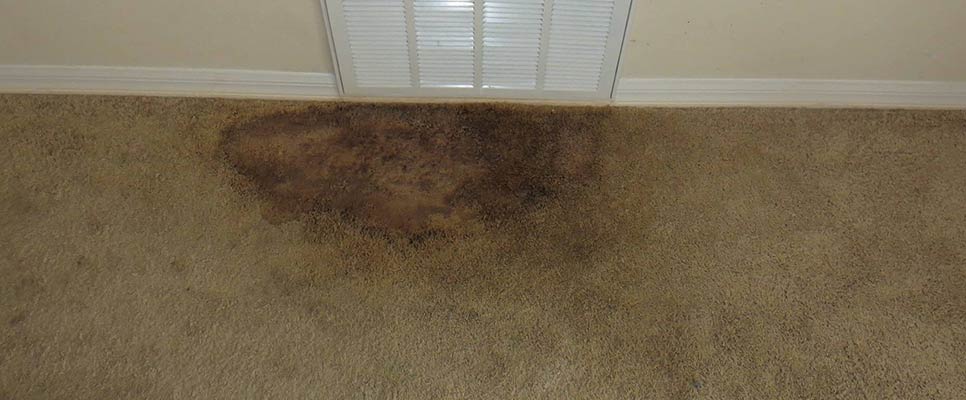Mould is a common problem in homes, and carpets are one of the most common areas where it grows. Mould is not only unsightly but also poses health risks, especially for people with allergies or respiratory problems. If you have mould on your carpet, it is important to take immediate action to remove it.

Signs of Mould infestation in Carpets
Mould infestation in carpets can be a serious problem, as it not only damages the carpet but can also have adverse effects on the health of the occupants of the space. Some signs of mould infestation in carpets include:
- Discolouration: If you notice any patches or areas of discolouration on your carpet, this could be a sign of mould growth. The discolouration may be green, black, or white.
- Musty Odour: Mould has a distinct musty odour, so if you notice an unpleasant smell emanating from your carpet, it could be a sign of mould infestation.
- Allergic Reactions: If you or anyone in your household is experiencing allergic reactions such as sneezing, coughing, or respiratory problems, it could be due to mould spores in the carpet.
- Dampness: If the carpet feels damp or moist, this could be a sign of moisture buildup, which can lead to mould growth.
- Visible Growth: If you can see visible mould growth on your carpet, it is a clear sign of infestation.
If you suspect that you have a mould infestation in your carpet, it is important to take immediate action to address the issue. This may involve removing and replacing the affected carpet, cleaning the carpet thoroughly, or seeking professional carpet repair assistance from a mould remediation specialist.
Here are some tips on how to get rid of mould on your carpet:
- Identify the Mould
The first step in getting rid of mould is to identify the affected area. Mould can appear in different colours, including green, black, and white. If you see a patch of mould on your carpet, it is likely to be accompanied by a musty odour. If you suspect that there is mould but cannot see it, you may need to call a professional for help.
- Dry the Affected Area
Mould thrives in damp conditions, so the next step is to dry the affected area. Use a fan or dehumidifier to remove moisture from the carpet. You can also open windows or use a heater to increase air circulation. Make sure that the affected area is completely dry before proceeding to the next step.
- Vacuum the Mould
Use a vacuum cleaner with a HEPA filter to remove as much mould as possible. Make sure that you clean the filter and dispose of the vacuum bag or contents after use. Avoid using a regular vacuum cleaner as it can spread mould spores throughout your home.
- Apply a Cleaning Solution
There are several cleaning solutions that you can use to remove mould from your carpet. One of the most effective is a mixture of vinegar and water. Mix equal parts vinegar and water in a spray bottle and apply it to the affected area. Let the solution sit for 10-15 minutes before using a clean cloth to blot the area. You can also use a commercial carpet cleaner or a mixture of baking soda and water.
- Rinse and Dry the Carpet
After applying the cleaning solution, rinse the carpet with clean water to remove any remaining mould and cleaning solution. Use a clean cloth to blot the area and then use a fan or dehumidifier to dry the carpet thoroughly. Make sure that the carpet is completely dry to prevent mould from growing again.
- Prevent Future Mould Growth
To prevent mould from growing on your carpet again, it is important to maintain a clean and dry environment. Make sure that your home is well-ventilated and use a dehumidifier if necessary. Clean up spills immediately and avoid placing wet items on the carpet. You can also use a mould-resistant carpet pad and vacuum your carpet regularly to prevent the buildup of dust and dirt.
Can Mould Damage An Entire Carpet?
Yes, mould can definitely damage an entire carpet if left untreated. Mould thrives in moist environments and can grow rapidly on carpet fibres if there is excess moisture or humidity. Once mould begins to grow on a carpet, it can spread quickly and release spores into the air, causing health problems and unpleasant odours. If not addressed promptly, mould can cause irreparable damage to carpet fibres, requiring a full replacement. Prevention is key to avoiding mould growth on carpets, so it’s important to ensure proper ventilation, limit moisture and humidity levels, and address any water damage or leaks immediately.
Conclusion
Mould on your carpet can be a serious problem, but with the right tools and techniques, you can get rid of it. Remember to act quickly, dry the affected area, vacuum the mould, apply a cleaning solution, rinse and dry the carpet, and prevent future mould growth. If the problem persists, consider seeking professional help to ensure that your home is safe and mould-free.
Also Read:
- How To Get Cat Pee Out Of Carpet
- How do the experts repair your carpet without replacement?
- Why Is Carpet Repair On Time Necessary?
- How To Repair Carpet In Doorway?
- How Do You Get Orange Juice Stain Out of Carpet?
- Effective Techniques To Repair Your Damaged Carpet
- How To Remove Carpet From Stairs?
- How to Replace Your Carpet Worn Padding?
- Carpet Maintenance: Tips and Tricks for Extending Your Carpet’s Lifespan
- Carpet Stretching: What It Is and Why You Need It
Published on: April 10, 2023
Last updated on: June 10, 2023
